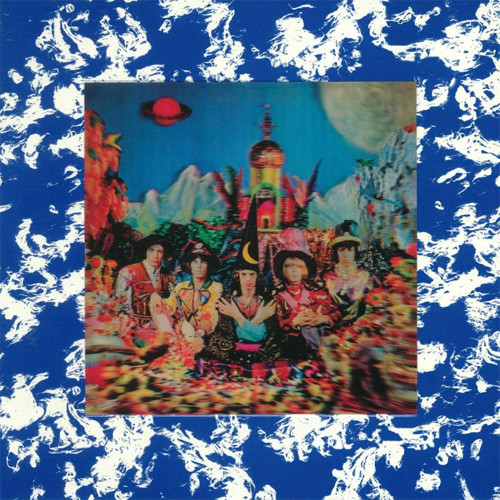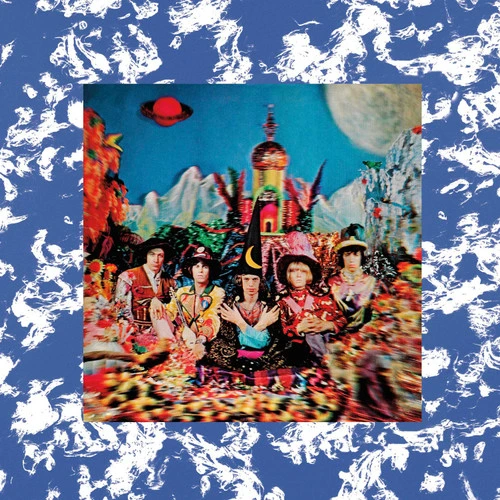Landmark 1967 Album On 180g Vinyl LP With Original Lenticular Cover!
Originally released in December of 1967, Their Satanic Majesties Request is the first self-produced album in the Stones' vast catalog. Experimental in nature, it was such a departure from the band's rhythm & blues roots that it threw critics for a loop. Over the ensuing decades, it has proven to be a highly influential body of work; generations of bands have covered Satanic songs, from punk legends The Damned, Bad Brains, and Redd Kross, to hard rockers KISS and Monster Magnet, as well as indie tastemakers Cibo Matto and Arcade Fire. Music from the album can be heard in Wes Anderson's directorial debut Bottle Rocket.
The title was derived from a pun based on the inside of British passports at the time which read, "Her Britannic Majesty's Principal Secretary of State for Foreign Affairs Requests and Requires . . ." Falling between Between the Buttons and Beggars Banquet, it was the first of their albums to have identical tracklists in the U.S. and UK. Satanic Majesties' ten tunes are saturated with studio effects, non-traditional instruments such as mellotron and theremin, ambient sounds created using oscillators, string arrangements by John Paul Jones (who went on to help establish Led Zeppelin the following year) and more percussive devices than can be named. Offered as a single just before the album's release, "In Another Land" is the only song in The Rolling Stones canon both written and sung by Bill Wyman, who took advantage of the fact that he was the lone member who showed up to the studio one day. The Small Faces happened to be recording next door, so Steve Marriott and Ronnie Lane were invited to contribute backing vocals, with Marriott also providing 12-string acoustic guitar. With Brian Jones on mellotron, Stones cohort Nicky Hopkins on harpsichord and Charlie Watts on drums, Mick and Keith laid down backing vocals, making it a complete Stones affair.
Michael Cooper, who had created the immaculate art for the Beatles' Sgt. Pepper's Lonely Hearts Club Band earlier in 1967, was hired by the Stones to make something equally striking for the cover of Their Satanic Majesties Request. All four Beatles' likenesses can be seen popping out of flowers, surrounding a photograph of Charlie, Keith, Mick, Brian and Bill in technicolor garb. Cooper used a rare 3-D camera, employing lenticular technology when the cover is tilted, the image changes, and every member except for wizard-hatted Mick appears to be moving their heads. Reproduction of the lenticular cover proved costly, and it was eliminated from many subsequent pressings of the album, being replaced by a still image.
"The first thing we did was 'Shes A Rainbow', then '2,000 Light Years From Home', then 'Citadel' and it just got freakier as we went along." - Mick Jagger
"Without a doubt, no Rolling Stones album -- and, indeed, very few rock albums from any era -- split critical opinion as much as the Rolling Stones' psychedelic outing. Many dismiss the record as sub-Sgt. Pepper posturing; others confess, if only in private, to a fascination with the album's inventive arrangements, which incorporated some African rhythms, Mellotrons, and full orchestration. What's clear is that never before or after did the Stones take so many chances in the studio. (Some critics and fans feel that the record has been unfairly undervalued, partly because purists expect the Stones to constantly champion a blues 'n' raunch worldview.) About half the material is very strong, particularly the glorious 'She's a Rainbow,' with its beautiful harmonies, piano, and strings; the riff-driven 'Citadel'; the hazy, dreamlike 'In Another Land,' Bill Wyman's debut writing (and singing) credit on a Stones release; and the majestically dark and doomy cosmic rocker '2000 Light Years from Home,' with some of the creepiest synthesizer effects (devised by Brian Jones) ever to grace a rock record. The downfall of the album was caused by some weak songwriting on the lesser tracks, particularly the interminable psychedelic jam 'Sing This All Together (See What Happens).' It's a much better record than most people give it credit for being, though, with a strong current of creeping uneasiness that undercuts the gaudy psychedelic flourishes. In 1968, the Stones would go back to the basics, and never wander down these paths again, making this all the more of a fascinating anomaly in the group's discography." - Richie Unterberger, AllMusic
Features:
• Vinyl LP
• Original artwork with restored lenticular image
• Gatefold jacket
Selections:
Frontside:
1. Sing This All Together
2. Citadel
3. In Another Land
4. 2000 Man
5. Sing This All Together (See What Happens)
Backside:
1. She's A Rainbow
2. The Lantern
3. Gomper
4. 2000 Light Years From Home
5. On With The Show
Originally released in December of 1967, Their Satanic Majesties Request is the first self-produced album in the Stones' vast catalog. Experimental in nature, it was such a departure from the band's rhythm & blues roots that it threw critics for a loop. Over the ensuing decades, it has proven to be a highly influential body of work; generations of bands have covered Satanic songs, from punk legends The Damned, Bad Brains, and Redd Kross, to hard rockers KISS and Monster Magnet, as well as indie tastemakers Cibo Matto and Arcade Fire. Music from the album can be heard in Wes Anderson's directorial debut Bottle Rocket.
The title was derived from a pun based on the inside of British passports at the time which read, "Her Britannic Majesty's Principal Secretary of State for Foreign Affairs Requests and Requires . . ." Falling between Between the Buttons and Beggars Banquet, it was the first of their albums to have identical tracklists in the U.S. and UK. Satanic Majesties' ten tunes are saturated with studio effects, non-traditional instruments such as mellotron and theremin, ambient sounds created using oscillators, string arrangements by John Paul Jones (who went on to help establish Led Zeppelin the following year) and more percussive devices than can be named. Offered as a single just before the album's release, "In Another Land" is the only song in The Rolling Stones canon both written and sung by Bill Wyman, who took advantage of the fact that he was the lone member who showed up to the studio one day. The Small Faces happened to be recording next door, so Steve Marriott and Ronnie Lane were invited to contribute backing vocals, with Marriott also providing 12-string acoustic guitar. With Brian Jones on mellotron, Stones cohort Nicky Hopkins on harpsichord and Charlie Watts on drums, Mick and Keith laid down backing vocals, making it a complete Stones affair.
Michael Cooper, who had created the immaculate art for the Beatles' Sgt. Pepper's Lonely Hearts Club Band earlier in 1967, was hired by the Stones to make something equally striking for the cover of Their Satanic Majesties Request. All four Beatles' likenesses can be seen popping out of flowers, surrounding a photograph of Charlie, Keith, Mick, Brian and Bill in technicolor garb. Cooper used a rare 3-D camera, employing lenticular technology when the cover is tilted, the image changes, and every member except for wizard-hatted Mick appears to be moving their heads. Reproduction of the lenticular cover proved costly, and it was eliminated from many subsequent pressings of the album, being replaced by a still image.
"The first thing we did was 'Shes A Rainbow', then '2,000 Light Years From Home', then 'Citadel' and it just got freakier as we went along." - Mick Jagger
"Without a doubt, no Rolling Stones album -- and, indeed, very few rock albums from any era -- split critical opinion as much as the Rolling Stones' psychedelic outing. Many dismiss the record as sub-Sgt. Pepper posturing; others confess, if only in private, to a fascination with the album's inventive arrangements, which incorporated some African rhythms, Mellotrons, and full orchestration. What's clear is that never before or after did the Stones take so many chances in the studio. (Some critics and fans feel that the record has been unfairly undervalued, partly because purists expect the Stones to constantly champion a blues 'n' raunch worldview.) About half the material is very strong, particularly the glorious 'She's a Rainbow,' with its beautiful harmonies, piano, and strings; the riff-driven 'Citadel'; the hazy, dreamlike 'In Another Land,' Bill Wyman's debut writing (and singing) credit on a Stones release; and the majestically dark and doomy cosmic rocker '2000 Light Years from Home,' with some of the creepiest synthesizer effects (devised by Brian Jones) ever to grace a rock record. The downfall of the album was caused by some weak songwriting on the lesser tracks, particularly the interminable psychedelic jam 'Sing This All Together (See What Happens).' It's a much better record than most people give it credit for being, though, with a strong current of creeping uneasiness that undercuts the gaudy psychedelic flourishes. In 1968, the Stones would go back to the basics, and never wander down these paths again, making this all the more of a fascinating anomaly in the group's discography." - Richie Unterberger, AllMusic
Features:
• Vinyl LP
• Original artwork with restored lenticular image
• Gatefold jacket
Selections:
Frontside:
1. Sing This All Together
2. Citadel
3. In Another Land
4. 2000 Man
5. Sing This All Together (See What Happens)
Backside:
1. She's A Rainbow
2. The Lantern
3. Gomper
4. 2000 Light Years From Home
5. On With The Show




 Turntable Accessories
Turntable Accessories Headphone Accessories
Headphone Accessories Cable Accessories
Cable Accessories Vinyl Accessories
Vinyl Accessories Compact Disc Accessories
Compact Disc Accessories







